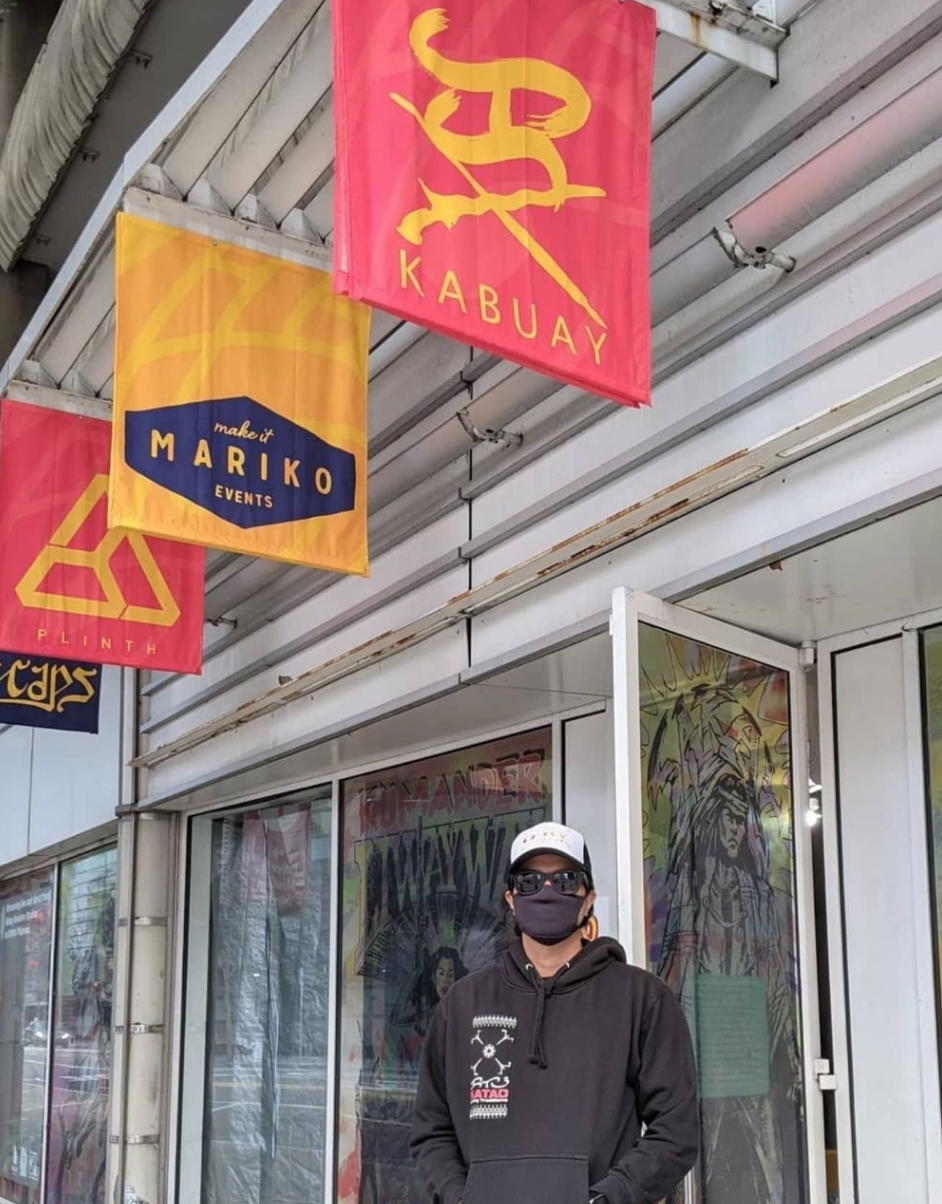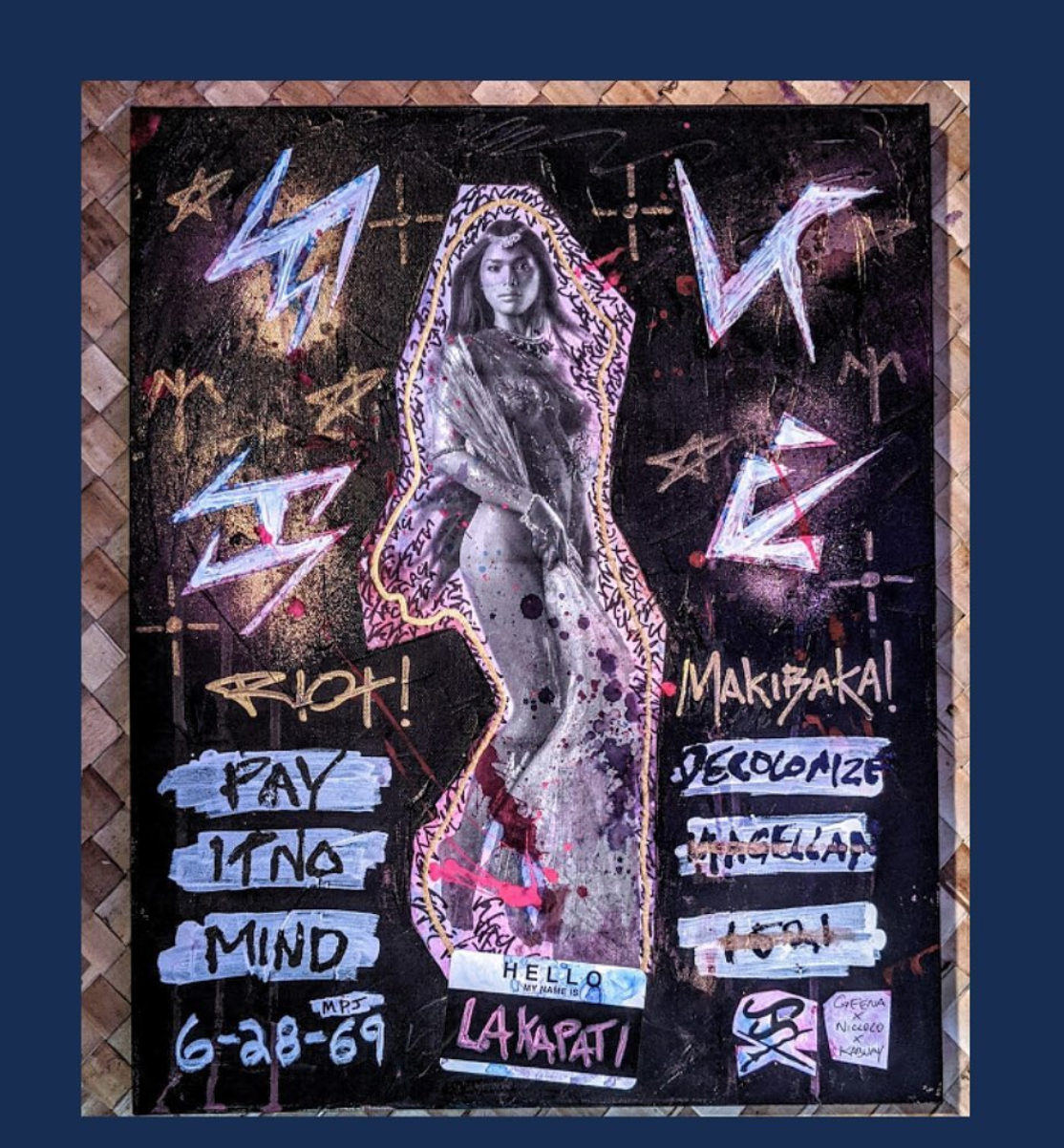Preserving Indigenous Philippine Art and Culture with Kristian Kabuay
Kristian Kabuay, one of Balay Kreative’s artists in residence, is a renaissance man. He defines himself as an artist and a cultural practitioner, but behind those titles there are layers of work and histories of wisdom embedded within them that seem to be endless. Specializing in pre-Philippine script known as Baybayin, Kristian has translated his drive for decolonizing our cultural heritage into art, books, films, tattoos, fashion, augmented reality, a TED Talk - the list goes on.
As one of the artists who worked on our Balay Jeepney-Bus Mural at Kapwa Gardens, along with Sami See, Maya Fuji, and Malaya Tuyay, we’re lucky to have Kristian widening our knowledge of our indigeneity through modern aesthetics. It’s not an easy feat to awaken people to the ways of our ancestors, to make them question everything they know because their lives have been funneled through a system of colonization. But this is a challenge worth taking because the end goal is not necessarily to have all the answers, but rather to begin asking questions.
In an interview with Jada Montez, Kristian speaks pointedly about his passions and what it’s like to be a Balay artist in residence, demonstrating how self-assured he is about his life’s work. He has a vision and a clear purpose as to where he’s coming from and where he wants to go next. We can’t wait to keep following him.
Profile by Chloe Samillano.
“Balay has helped me grow as an artist because I have a physical space where I can meet other artists. I can give back to the community and take the things I see right outside the doorsteps of Balay and create art for them.”
Can you tell us a little more about your art practice/artistic background?
I am an artist and cultural practitioner here in SOMA Pilipinas. My art practice is focused on pre-Philippines scripts and tattoos, just like many of us as kids, I would draw and create characters of my own world and I just never stopped. But now it’s rooted in this cultural practice from the Philippines.
Kristian in his studio space at Balay Kreative.
Why do you create? What is the purpose/values behind your art practice?
I mainly create to keep me out of trouble. There’s only so much Netflix, reading, and partying that you can do and all of those things are fun, but the art actually keeps me grounded, keeps me in touch with the community, with my family, and my ancestors.
How would you describe Balay Kreative?
Balay Kreative is literally a home. That’s what Balay means and I’ve lived in this area for years, also grew up in the area. I have fond memories from my parents and my grandparents in this area, so this is pretty much a homecoming for me.
“Like many of us as kids, I would draw and create characters of my own world and I just never stopped. But now it’s rooted in this cultural practice from the Philippines.”
How has Balay helped you grow as an artist?
Balay has helped me grow as an artist because I have a physical space where I can see people, meet other artists. I can give back to the community and I can take the things I see that are right outside the doorsteps of Balay and create art for them.
How has your experience been at Balay as a resident artist?
My experience at Balay reminds me of growing up in a neighborhood where you can just walk down the street and see peoples names and just say ‘hey what’s up?’. And now in times of people being spread apart and isolated online, it’s quite a refreshing experience.
How has it been like having your own studio space?
Having my own studio space is great because it’s not just a place where I can leave my artwork, but it’s also for other people to visit as well.
Kristian performing “batok”, an Indigenous tattoo practice in the Philippines.
What projects have you made here in Balay? What was it like to create them for the SOMA Pilipinas community?
The biggest project I created here was a ten-foot canvas piece that I did for a resident here in SOMA Pilipinas. And it was a pretty big piece where I took up half the space here. I was by myself on a Saturday morning, pumped up the music, and it was very meditative and refreshing because I never had a space to do that.
How long did it take you to make the piece?
It took me really quick actually. It took me ten minutes to do, but took an hour to set up.
Oh wow, a ten foot piece?
Yes [Smiles]. I tend to create fast because as a kid I grew up tagging walls and stuff and you always have to look over your back for the cops. So I learned how to do my work quickly.
“The biggest project I created here was a ten-foot canvas piece that I did… which I took up half the space here [in Balay]. I was by myself on a Saturday morning, pumped up the music, and it was very meditative and refreshing because I never had a space to do that.”
Balay Kreative’s mission is to accelerate the growth of Filipinx artistic expression in SOMA. How do you embody your Filipinx identity in your art?
I embody my Filipinx identity through my cultural practice of Philippine script and tattooing, that has been going on in the Philippines for over 4000 years. And with the script, hundreds of years. In the last 5 years, you can see the script here within SOMA Pilipinas. Even more within this district than the Philippines itself.
I’m actually gonna work on this practice skin [Grabs model of a skull]. It’s silicone. It mimics the actual human skin. So machine tattoo artists use this, but I’m gonna do it with tapping (aka batok) which is quite difficult and challenging because when you tap, the ink doesn’t go in as deep as a machine. But I’m gonna try.
Have you given a lot of people [hand-tapped tattoos]?
Yeah, I’m still learning. I started apprenticing in 2013 and have done a few. But it’s hard because you have to know the academics part of it. Like the patterns and the regions and the cultural context then you have to make your own tools too. And you have to physically know how to do it which is quite different from what people would do [when holding] a paintbrush. Because you’re using your off hand to guide the tattoo tool and then you’re hitting with your strong hand. [Demonstrates how to do it]. Usually when you’re gonna write or paint, you’re gonna use your strong hand, so it’s kinda awkward at first, but you know muscle memory.
“I mainly create to keep me out of trouble. There’s only so much Netflix, reading, and partying that you can do and all of those things are fun, but the art actually keeps me grounded, keeps me in touch with the community, with my family, and my ancestors. ”
What are you working on now?
I am currently working on these traditional tattoo cards, where I am using batok, which is the traditional practice, on these synthetic skins that I’m transferring into these trading cards.
What would be your dream project?
Oo, my dream project would include all the things that I’m into. There’s music, there’s technology, like augmented reality, also traditional art as well, such as tattooing, script, canvas, and education. So combining all of those into one project would be a dream.
What advice would you tell your younger self?
The advice I would’ve told myself was don’t try too hard at school. Even though I was a bad student, I still tried. And it didn’t really get me that financial freedom as what was promised to us by parents and the authorities. So I would’ve probably chosen to be more creative. Art, at school, is looked at as an elective rather than a focus where you can grow your creativity.
Any other things you’d like to say or promote?
You can follow me on my website, Kabuay.com. [It] links all of my social media. I invite everyone to come check out Balay Kreative and the studios, and maybe one day y’all can take part of this.
Inspired by Kristian Kabuay and his work? Apply to our Kreative Growth grant!
If chosen as a grantee, you will receive $3,000 - $6,000 to create and present new works of art & culture in SOMA Pilipinas. You will also receive free artist studio space, free tuition in our Kreative Growth Masterclass series, and 1:1 mentoring with industry professionals in your field of practice.
Deadline to apply is May 30, 2022 by 11:59PM PST.
Be sure to follow @balaykreative and subscribe to our newsletter to hear about Kristian'’s future artwork and other artist opportunities/events! Stay tuned of our upcoming profiles of other Balay Kreative artists in residence, Ramon Abad and Mirage Medicinal.



















